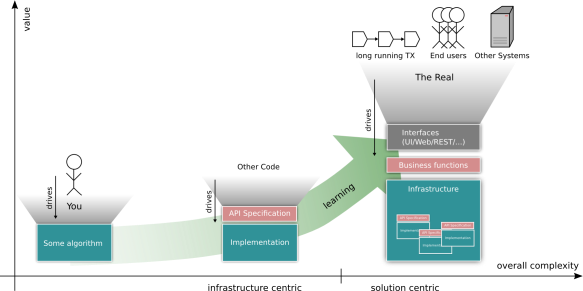As a student or programming enthusiast, you will spend considerable time getting your head around data structures and algorithms. It is those elementary concepts that make up the essential tool set to make a dumb machine perform something useful and enjoyable.
When going professional, i. e. when building software to be used by others, typically developers end up either building enabling functionality, e. g. low level frameworks and libraries (infrastructure) or applications or parts thereof, e. g. user interfaces, jobs (solutions).
There is a cultural divide between infrastructure developers and solution developers. The former have a tendency to believe the latter do somehow intellectually inferior work, while the latter believe the former have no clue about real life.
While it is definitely beneficial to develop skills in API design and system level programming, without the experience of developing and delivering an end-to-end solution however, this is like knowing the finest details on kitchen equipment without ever cooking for friends.
The Difference
A typical characteristic of an infrastructure library is a rather well-defined problem scope that is known to imply some level of non-trivial complexity in its implementation (otherwise it would be pointless):
Local complexity is expected and accepted.
In contrast, solution development is driven by business flows, end-user requirements, and other requirements that are typically far from stable until done and much less over time. Complete solutions typically consists of many spread out – if not distributed – implementation pieces – so that local complexity is simply not affordable.
Distributed complexity is expected, local complexity is not acceptable.
The natural learning order is from left to right:
Conclusion
Unfortunately many career and whole companies do not get past the infrastructure/solution line. This produces deciders that have very little idea about “the real” and tend to view it as a simplified extrapolation of their previous experience. Eventually we see astronaut architectures full of disrespect for the problem space, absurd assumptions on how markets adapt, and eventually how much time and reality exposure solutions require to become solid problem solvers.

